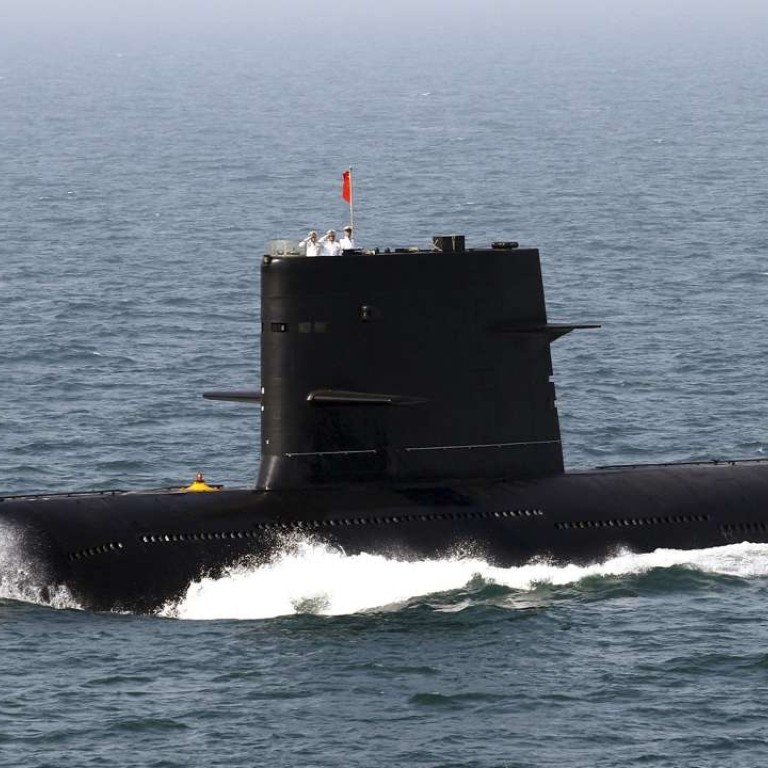
China and US in silent fight for supremacy beneath waves of South China Sea
The PLA Navy has dramatically extended the reach of its submarines in the contested waters, raising the risk to US warships, experts say
As the world focuses on the war of words between China and the US over the militarisation of the disputed South China Sea, a silent, underwater fight for supremacy between the two countries is heating up.
US Defence Secretary Ash Carter said in a speech in New York in April that the US would spend more than US$8 billion next year to ensure it had “the most lethal and most advanced undersea and anti-submarine force in the world”. That budget – a roughly 14 per cent increase – will include spending on the development of undersea drones.
PLAN subs can operate more regularly with the facilities in the South China Sea, such as Fiery Cross, and they will be in a better position to monitor US naval movements
Two months earlier, Admiral Harry Harris, the head of the US Pacific Command, complained to lawmakers in Washington that “I don’t have the submarines that I feel I need” to counter Chinese militarisation of the South China Sea.
The People’s Liberation Army Navy now has about 70 submarines – very close to the US’ total – with 16 of them nuclear-powered, according to the Pentagon’s annual report to Congress last year on China’s military and security development. Fifteen of China’s non-nuclear submarines are stealthy, equipped with quiet Stirling air-independent propulsion (AIP) engines that also allow them to stay submerged for longer.
The US Navy operated 75 nuclear-powered submarines in 2014, with around 15 being the more modern Virginia or Seawolf-class designs, according to the World Nuclear Association. However, it deploys just four Los Angeles-class submarines in the Asia-Pacific region, operating out of its naval base in Guam.
The PLA Navy’s submarine fleet could get an even higher profile soon, sources close to the PLA have told the South China Morning Post, with veteran submarine commander Admiral Sun Jianguo, deputy chief of the PLA’s Joint Staff Department, among the contenders to succeed Admiral Wu Shengli as head of the navy at next year’s Communist Party congress.
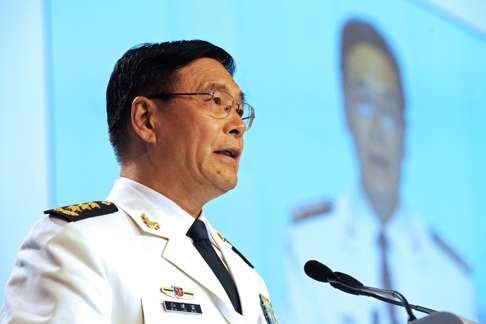
Sun, 64, was captain of the PLA’s first operational nuclear submarine, Long March III, in 1985 when the newly launched submarine set a world record by submerging for 90 days, eclipsing the previous record of 84 days held by a US submarine.
This year and last, Sun has been Carter’s Chinese counterpart at the annual Shangri-La Dialogue in Singapore, a regional security forum that has been dominated by the South China Sea row recently.
Years ago, the US Pacific fleet used to mock Chinese submarines for being too noisy and too easy to detect, but that changed when they successfully tailed US aircraft carriers in the East China Sea in recent years.
In 2006, a People’s Liberation Army Navy Type 039 (Song class) diesel-electric submarine surfaced within five nautical miles (9km) of the USS Kitty Hawk when the aircraft carrier was on a training exercise in the East China Sea between Japan and Taiwan.
And last October, officers on board the aircraft carrier USS Ronald Reagan were shocked when they discovered that a People’s Liberation Army Navy attack submarine had sailed “very close” to it near Japanese waters, the Washington Free Beacon reported, citing American defence officials.
A few days after that close encounter with the PLA, the Pentagon sent the destroyer USS Lassen to sail within 12 nautical miles of Subi Reef, one of seven man-made Chinese islands in the Spratly Islands in the South China Sea on a so-called freedom of navigation operation. Washington and Beijing pointed fingers at each other for escalating tension and militarising the disputed waters, which are claimed wholly or in part by mainland China, Vietnam, the Philippines, Malaysia, Brunei and Taiwan.
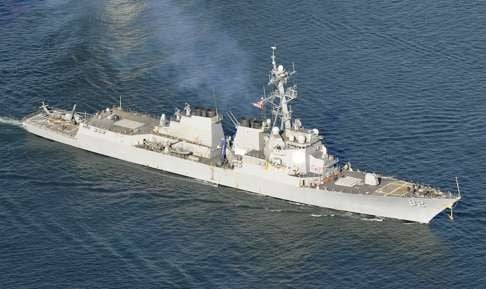
The US has also conducted joint drills with Japan and the Philippines in the South China Sea
Meanwhile, Beijing’s reclamation of almost 13 square kilometres of land in the Spratlys in the past two years, including the construction of airstrips up to 3km long on three of the artificial islands, has added to US concerns about access to the South China Sea.
The 3.5 million square kilometre sea is one of the world’s busiest trade routes. China claims nearly 2 million square kilometres of it, and to help protect that claim has built Asia’s largest submarine base, Yulin, on the south coast of Hainan, near Sanya. The base features underground submarine facilities with tunnel access, shielding Chinese submarines that enter the South China Sea from the prying eyes of US reconnaissance satellites.
It’s an open secret that the US has been sending submarines and spy planes to the South China Sea since early 2000, when it realised Beijing was starting to build the submarine base. The collision between a PLA fighter jet and a US EP-3 spy plane off the coast of Hainan in April 2001 that killed a Chinese pilot was the most serious incident to date in the two countries’ anti-submarine warfare contest.
Collin Koh Swee Lean, a submarine expert from the S. Rajaratnam School of International Studies at Singapore’s Nanyang Technological University, said a newly built deep-water port at Fiery Cross Reef in the Spratlys, more than 1,000km from Sanya, could extend the PLA Navy’s reach.
“We can see the PLAN subs having ‘longer legs’ in operating for more sustained periods in the South China Sea without the need to frequently return to their home bases in Hainan or the mainland coast,” Koh said. “PLAN subs can operate more regularly with the facilities in the South China Sea, such as Fiery Cross, and they will be in a better position to monitor US naval movements. Such ‘cat-and-mouse’ tracking and counter-tracking operations could be reminiscent of what happened between American and Soviet naval forces.”
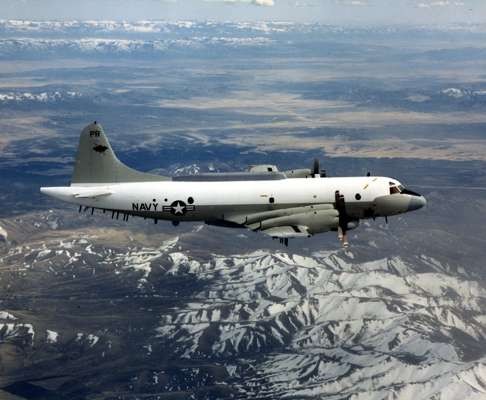
With more close surveillance operations by Chinese, American or Japanese submarines conceivable in the South China Sea as the US presses ahead with freedom of navigation operations, Koh said the risk of collisions between submarines and even naval surfaces vessels had increased.
“If we take note of the numerous incidents that happened back during the cold war, the prospect of such incidents in the South China Sea can easily result in a diplomatic event that can be embarrassing for either party and add to tensions,” Koh warned.
A nine-day tour of the Spratlys in May by an entertainment troupe starring military folk singer Song Zuying that performed to audiences of workers and troops was seen as a signal that construction work on naval ports on the man-made islands had been completed. State-owned China Central Television showed the amphibious transport dock Kunlun Shan, the PLA Navy’s second-biggest warship, which took the troupe to the islands, anchored close to Fiery Cross Reef.
“Building naval ports and airstrips in the Spratly archipelago extends China’s air force reach in the region by at least 1,000km from Yongxing (Woody Island),” Beijing-based naval expert Li Jie said, adding they would enable the provision of air, naval and land support to Chinese submarines.
The PLA has already deployed long-range HQ-9 surface to air missiles, J-10 and J-11 fighter jets and sophisticated radar systems on Woody Island in the disputed Paracel Islands, which are claimed by Beijing, Hanoi and Taipei.
In April, a military source told the Post that Beijing planned to start reclamation work at Scarborough Shoal, just 230km off the coast of the Philippines and more than 900km from Sanya, later this year and might add an airstrip there to further extend the air force’s reach.
China is now concentrating on its latest nuclear-powered submarine, the Type 094 or Jin-class, most of which are based at Yulin. Four of the boats are operational, with a fifth under construction, according to the Pentagon’s report to congress.
It said they were expected to be equipped with up to 12 JL-2 ballistic missiles – with an estimated range of 7,400km, enough to reach US territory from the waters of the Western Pacific – and were considered a “credible sea-based nuclear deterrent”.
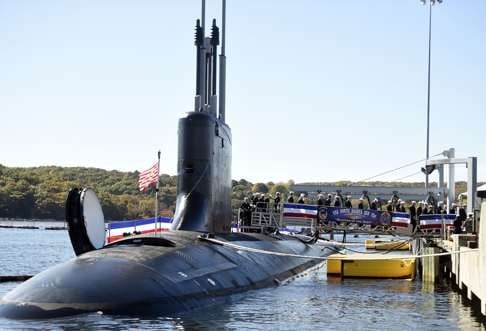
The Pentagon said China was also developing an improved, third-generation nuclear-powered ballistic missile submarine, the Type 096, to be fitted with JL-3 long-range missiles that could reach the US from the waters of the South China Sea.
“Chinese attack submarines in the South China Sea, if they can remain undetected, would raise the costs and risks for American warships operating in the area,” said Ashley Townshend, a research fellow at the US Studies Centre at the University of Sydney in Australia.
“Stealthy attack subs could potentially challenge the US Navy’s capacity for freedom of navigation at acceptable levels of risk, but only if China can improve its lagging anti-submarine warfare capabilities and neutralise the US lead in this domain.”
Toshi Yoshihara, an associate professor at the US Naval War College, said he had expected the US, which had maintained a formidable edge in the undersea domain, would continue to invest in its submarine force to keep and even widen its lead.
Last autumn, the US Navy’s Office of Naval Research unveiled a three-metre-long semi-autonomous submarine drone capable of acoustic surveillance, anti-submarine warfare (ASW) and other offensive operations longer than 70 days in the open ocean and littoral seas.
The navy said it could be stowed in Virginia- and Ohio-class submarines and would reach initial operating capability as a squadron by 2020, with production fully ramped up by 2025.
Yoshihara said the underwater drones had the potential to significantly advance America’s already sophisticated anti-submarine warfare capabilities.
“[The drones] will inject a degree of uncertainty into the minds of Chinese defence planners about the ability of the US Navy to quietly track, and therefore kill, Chinese subs in shallow parts of the South China Sea or in waters close to Chinese ports,” he said. “Sub drones may be small enough to bypass Chinese sonars and ASW defences, making them hard for the PLA Navy to combat and complicating China’s aim to operate its own subs clandestinely in the South China Sea.”
China is already taking steps to forestall that development.
Last month, British-based IHS Jane’s Defence Weekly reported that state-owned shipbuilding giant China State Shipbuilding had proposed building a sound surveillance system nicknamed the underwater great wall project –a network of ship and subsurface sensors that could significantly erode the undersea warfare advantage held by US subs and help it control the South China Sea.
Shanghai-based naval expert Ni Lexiong warned that an anti-submarine warfare arms race could be about to break out, similar to the submarine arms race that helped cripple the German economy in the second world war.
“I hope China will not follow it,” he said.

